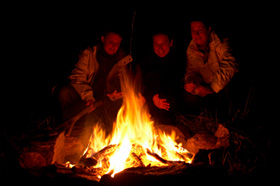 For many people, camping just wouldn't be camping without a campfire. A place to gather and relax after a busy day of outdoor activities; to keep you warm, to toast your marshmallows or even cook your meals on, a campfire can be one of the best things about camping.
For many people, camping just wouldn't be camping without a campfire. A place to gather and relax after a busy day of outdoor activities; to keep you warm, to toast your marshmallows or even cook your meals on, a campfire can be one of the best things about camping.
Building a Campfire
Follow these 7 steps to build a great campfire safely:
- Find a suitable spot for your campfire
- First, check with the campsite to make sure fires are allowed
- Build your campfire at a least 10 feet from sleeping and eating areas. Clear an area of at least 3 feet on all sides of the fire to help prevent inadvertent lighting of other materials that could be near. Keep people at least 3 feet from the fire's flames
- Use an existing, preferably campsite provided, fire ring. Or even better, build your fire in a metal fire pan (available at outdoor shops), which helps to control the flames and leaves no trace of a fire
- Look out for an area that is well sheltered as wind can spread fires
- Never build a fire so close to a rock, tree or cliff face that it blackens the surface. Nobody likes to look at charred wilderness
- Gather your firewood
- You will need kindling (twigs/small sticks, shaved wood, dried leaves, grass or paper) sticks and logs or large pieces of wood
- It is important that the materials are dry and that you use only fallen branches, rather than those taken from living trees. Not only is this environmentally unsound, but the wood will be too green, rather than dry. Also, try not to use rotted wood, which is often damp in its center
- Some parks and wilderness areas even forbid gathering fallen material, which plays an important role in the ecosystem, so if you are staying at a park check with the ranger first, otherwise you will have to bring your own materials from outside the park
- Put a couple of handfuls of kindling rolled into a ball into the center of the fire ring.
- Arrange the small sticks in a pyramid or tepee shape around the kindling.
- There needs to be space to allow oxygen to circulate and let the fire breath, so don't build it too densely.
- Leave a small opening so that a match can reach the kindling beneath.
- Light the kindling with a match (or you can use a disposable lighter).
- Your kindling should burn first and then spread to the pyramid of sticks.
- Make sure the flames of the kindler are burning directly underneath the wood to give it a chance to light.
- Once the sticks have taken light, gradually add increasingly larger sticks and then logs as the fire grows in strength.
- Never just toss the logs onto the fire try to maintain the tepee shape at least initially.
- Leave space between the wood for the fire to breathe.
- If your fire has trouble lighting, add more kindling and small sticks.
- Carefully blow around the base of the fire to help it grow.
- If you are having real difficulty or you have poor conditions for starting a fire, you can use fireplace starters, which are sold in brick form and can be bought almost anywhere.
- If you need to move any of the burning logs around, find a long thin stick like piece of wood to poke it with. Never do it with your hands or other body parts.
Putting Out Your Campfire
Any fire that's started also needs to be put out. You should extinguish your campfire before you go to bed or before you leave the area. The safest and easiest way to do this is to pour water over the fire. If it still smokes after the addition of water, throw a few shovels of dirt on top.
Copyright ©2009 Camping Road Trip, LLC
Find campgrounds and RV parks - Smart Search Now.
Read campground and RV park reviews to help you find the perfect place to stay.